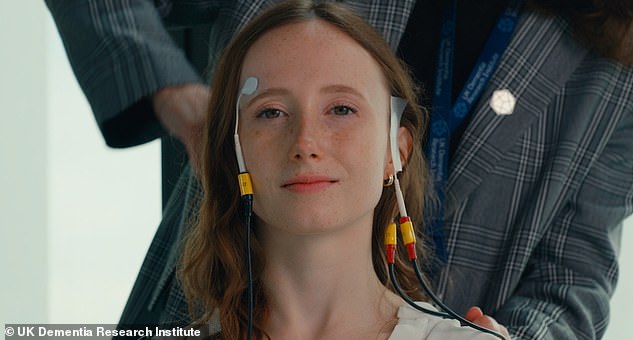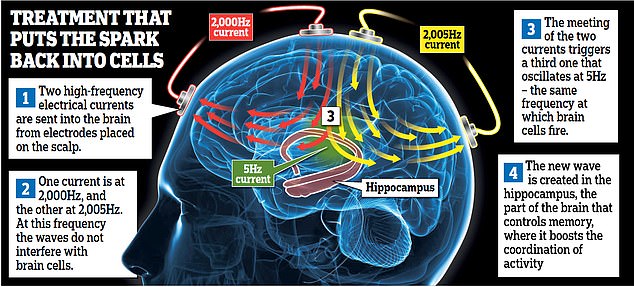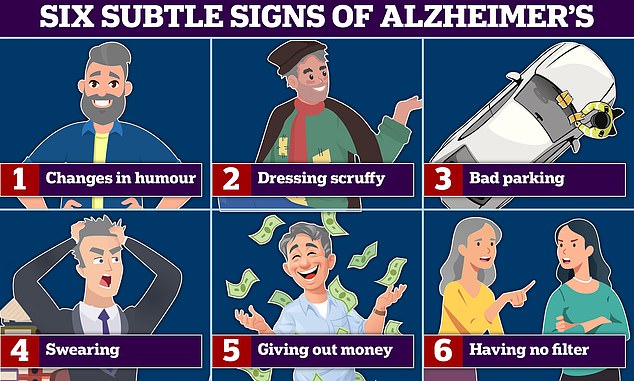Hope in battle against Alzheimer’s as landmark trial reveals electrically stimulating brain can boost memory: Scientists say game-changing tech is safe
A groundbreaking study has confirmed that sending electrical currents deep into the brain can improve memory, with results paving the way for future studies in Alzheimer’s patients.
Neurologists have developed a technology called temporal interference brain stimulation, which involves applying electrodes to the scalp to send high-frequency beams to the brain.
The beams have slightly different frequencies – for example 2,000 Hz and 2,005 Hz – and when they cross they create a low-frequency wave of 5 Hz.
This low-frequency wave is activated in the hippocampus – an area deep in the brain responsible for forming new memories.
It works by stimulating the coordination of activities involved in forming memories in cells in this part of the brain.

Neurologists have developed a technology called temporal interference brain stimulation, which involves applying electrodes to the scalp to send high-frequency beams to the brain. The beams have slightly different frequencies – for example 2,000 Hz and 2,005 Hz – and when they cross they create a low-frequency wave of 5 Hz. This low-frequency wave is activated in the hippocampus – an area deep in the brain responsible for forming new memories

The team tested their technology on twenty healthy volunteers, who wore the electrodes for 30 minutes at a time while they memorized faces and names.
Analysis showed that it increased memory accuracy by as much as 20 percent without disrupting healthy brain tissue.
Experts have described the technology as ‘incredible’ as it opens a new avenue for treating brain diseases such as Alzheimer’s.
Until now, electrically stimulating structures deep in the brain required surgery.
The team, from the UK’s Dementia Research Institute at Imperial College London, together with the University of Surrey, has now started testing the technique in people with early Alzheimer’s.
Dr. Nir Grossman, who led the study, said: ‘Until now, if we wanted to electrically stimulate structures deep in the brain, we had to surgically implant electrodes in the brain, which obviously poses risks to the patient and can lead to complications. .
‘With our new technology, we have shown for the first time that it is possible to remotely stimulate specific areas deep in the human brain without the need for surgery.
‘This opens up a completely new treatment option for brain diseases such as Alzheimer’s disease, which affect deep brain structures. We hope this will help increase the availability of deep brain stimulation therapies by dramatically reducing costs and risks.
‘We are now testing whether repeated treatment with the stimulation over a number of days can benefit people in the early stages of Alzheimer’s disease.
‘We hope this will restore normal brain activity in the affected areas, which could improve symptoms of memory impairment.’
Nearly a million people in Britain are living with dementia, and this number is expected to rise to 1.6 million by 2040.
Commenting on the results, Dr Richard Oakley, Associate Director of Research and Innovation at the Alzheimer’s Society, said: ‘This is incredible technology.
‘Currently, treatments for Parkinson’s disease are used that stimulate areas deep in the brain, but these involve invasive operations from which recovery can take months.
‘This research shows that it is possible to do deep brain stimulation by simply wearing a headset. Furthermore, this stimulation can improve performance on memory tasks in healthy people.
‘Dementia is a devastating terminal disease and the biggest cause of death in Britain, so it’s really exciting to see research opening up whole new areas for future treatment, but it’s just the beginning.
‘We look forward to seeing how the research develops, especially how long-lasting the changes might be for people with Alzheimer’s disease.’

Changes in humor and increased swearing are all signs of Alzheimer’s disease and frontotemporal dementia (FTD) – a form of dementia that causes problems with behavior and language. According to experts, poor parking and shabby clothes are also signs of the memory-robbing disease. Graphic shows: six signs of Alzheimer’s disease
Richard Morris, professor of neuroscience at the University of Edinburgh, said: ‘This work is potentially an amazing step forward and I congratulate the authors on developing their non-invasive targeting of focal stimulation in deep brain structures such as the hippocampus.’
Dr. Leah Mursaleen, head of research at Alzheimer’s Research UK, said: ‘While there are a number of promising new drugs in the pipeline for people with early-stage Alzheimer’s disease, they have not yet been approved by regulators and, even if they are are, it is possible that they do not. are suitable for everyone.
‘With almost a million people living with dementia in Britain today, it is crucial that we also look at other ways that can help people manage their symptoms.
‘Although deep brain stimulation is available as a treatment option for some brain disorders, such as Parkinson’s disease, current techniques require complex brain surgery.
‘So it’s fantastic to see British researchers exploring promising new ways to reach the brain that don’t require invasive procedures.
‘It is important to note that this study was conducted among a small group of healthy volunteers. Therefore, the results of the next clinical trial, which will assess this exciting technique in people with early Alzheimer’s disease, will give us further insight into whether this technique can help improve their memory.’
The findings have been published in the journal Nature Neuroscience.
